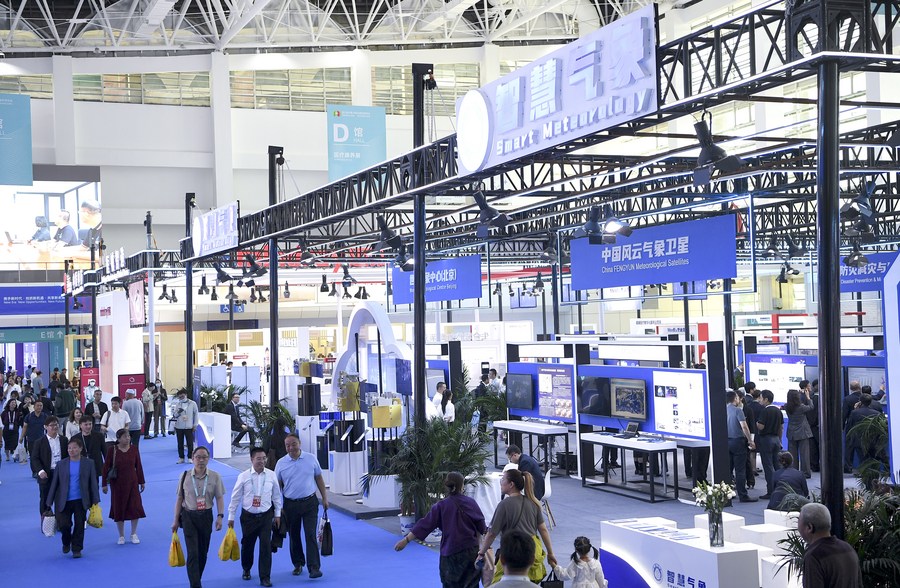Sci-tech meteorological cooperation deepens ties between China, Arab states

This photo taken on Sept. 21, 2023 shows the smart meteorology exhibition area at the sixth China-Arab States Expo in Yinchuan, northwest China's Ningxia Hui Autonomous Region. (Xinhua/Feng Kaihua)
YINCHUAN, Sept. 26 (Xinhua) -- As the sixth China-Arab States Expo rang down the curtain on Sunday in Yinchuan, the capital city of northwest China's Ningxia Hui Autonomous Region, international cooperation between China and Arab countries in the field of meteorology entered a new chapter.
Ten years on, it was the first time for the biennial expo to include a conference on meteorological development and cooperation, addressing natural disasters and climate change, while also providing meteorological services for countries participating in the Belt and Road Initiative.
In the context of global warming, the frequent occurrence of extreme weather events, including high temperatures, typhoons and rainstorms, poses a great threat to human beings. This situation necessitates international cooperation to effectively address this issue.
For the meteorological experts from China and nine Arab countries including Saudi Arabia, the United Arab Emirates (UAE), Jordan, Mauritania, Comoros and Egypt, who attended the conference, it's high time to discuss these shared challenges and search for joint opportunities in terms of global climate changes.
"China and Arab states built a good friendship thousands of years ago through the ancient Silk Road. Now the two sides are deepening their ties in meteorological exchanges and cooperation," said Zeng Qin with the China Meteorological Administration (CMA).
Meteorological science and technology were highly mentioned throughout the conference, which also included an exhibition for Chinese advanced meteorological equipment and technologies, earning interest and appreciation from the Arab experts.
Juma Said Ahmed Al-Maskari, meteorologist of the Gulf Cooperation Council (GCC) told Xinhua that he was fascinated by the science and technology showcased at the exhibition. He believes that these advancements can greatly enhance the field of meteorology by offering more specific, specialized, and timely services.
"International meteorological cooperation is really important. In the forum on satellites we learn quite a lot of expertise from both sides," he said, "We also enjoy the exhibition where we see a lot of companies and CMA products. Companies show lots of equipment that can be used in various fields like meteorological station, new mechanics, and weather prediction."
The meteorologist added that he looks forward to signing a memorandum of understanding between GCC countries and CMA with China's Fengyun meteorological satellites' services included.
According to Wang Jinsong, director of the National Satellite Meteorological Center (NSMC), Fengyun meteorological satellites play an important role in early warnings in terms of disaster prevention and reduction. Among the nine Fengyun meteorological satellites on orbit, there is a satellite, which is known as the "Belt and Road satellite," as it addresses the previously unmet need for meteorological satellite observation on the Indian Ocean and provides 24-hour monitoring services and meteorological data for most Arab countries.
So far, Fengyun meteorological satellites have provided services for 129 countries, among which 10 Arab states have become users of the satellites' data. China has offered meteorological training to more than 2,000 people from 22 Arab League member states.
China has always highlighted meteorological collaborations with Arab states, said Chen Zhenlin, director of CMA, adding that the CMA and the National Center of Meteorology (NCM) of UAE signed a bilateral intergovernmental memorandum of cooperation on meteorological science and technology early this year, while during the conference the two sides agreed to further cooperate in fields such as AI, satellites' monitoring, information and communication, and education and training.
Abdulla Ahmed Yousuf Ahmed Almandous, president of the World Meteorological Organization and also director general of the NCM of UAE, said he hopes that China's high-tech and modernization development will help better carry out the memorandum and deepen international meteorological cooperation.
The state-owned company China Huayun Meteorological Technology Group Corporation signed a framework agreement on meteorology with Mauritania and Comoros, agreeing to cooperate in early warning, meteorological science and technology and other fields. The company will conduct online and offline training for staff in both countries.
"This agreement is quite important for us, and I believe it will help tie our two countries closer and achieve a win-win result," said Mohamed Mahmoud Ba, general director of the National Office of Meteorology of Mauritania.
According to Luo Hui, director of the Ningxia meteorological bureau, with the support of the NSMC and World Meteorological Centre Beijing, Ningxia launched a platform during the expo to help countries along the Silk Road Economic Belt with disaster prevention and reduction.
"The platform can now provide 26 kinds of remote-sensing monitoring services including the monitoring of real-time weather, land surface and disastrous weather," Luo said.

